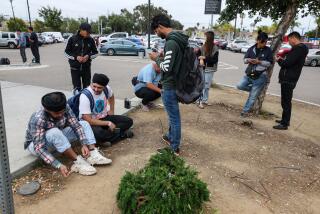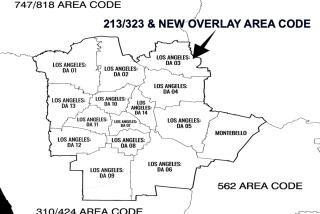State Cancels the Call to Split 818 Area Code
- Share via
Nearly half of the 8 million phone numbers in the 818 area code are not being used, eliminating any immediate need to split the San Fernando Valley into two area codes or establish an “overlay,” state officials said Tuesday.
Pacific Bell and other phone companies had supported creating a new area code in the Valley, saying the region was running out of phone numbers.
But the state Legislature blocked those plans last year, passing a bill that would require a number-use study before any new code could be established.
That study, released by the California Public Utilities Commission on Tuesday, concluded that the 818 area and three others have “considerable room for growth, resulting in no need for the area codes to be split or overlaid.”
An overlay is an area code within an area code. New phones are given the new code, but all users in the overlay area must dial an area code--even for local calls.
Public dislike of the plan, and skepticism of the need for new numbers, led state Assemblyman Wally Knox (D-Los Angeles) to introduce AB 818 to force the study of how phone companies are using their numbers.
But Knox said even he was surprised by the large amount of available phone numbers.
“I don’t think anyone a year ago would have predicted half of the numbers were not being used,” Knox said. “This is a stunning revelation and a vindication.”
The report said about 3.9 million numbers are available in the 818 area code, including 1.2 million set aside by the commission for assigning in blocks to telecommunications companies, 1.8 million being held by hard-wired phone companies including Pacific Bell, and 834,000 by wireless companies.
Last year, Pacific Bell and other companies had argued that the explosion in demand for cellular phones, fax machines, Internet connections and other uses made an overlay or split necessary.
Critics argued that numbers were not being conserved. As part of AB 818, numbers will start being allocated in blocks of 1,000, instead of blocks of 10,000.
Pacific Bell spokeswoman Jennifer Langan said Tuesday that her company is using 85% of the numbers assigned to it.
“There’s going to be a point in the future where we are going to need more numbers,” she said.
Helen Mickiewicz, an attorney for the utilities commission, said the report suggests there will be no need to split or overlay the 818 area for at least a year, “and probably longer.
“There are no guarantees,” she added. “It depends on demand, and whether it stays the same or goes up or down.”
Mickiewicz said the utilities commission probably will start assigning numbers in blocks of 1,000 early next year.
In other regions, that system has already reduced the need for more numbers.
“It’s been a big, big change,” Mickiewicz said. “It’s slowed down the need to hand out new numbers.”
In the past, for example, a small telecommunications company might be assigned 10,000 numbers but could only use 1,000 of them--meaning 9,000 numbers would be tied up and not available to other companies.
With the new system, “we don’t need to put in a new area code as soon,” she said. “The life of an area code is extended.”
The utilities commission report also examined the 415 and 510 area codes, both in the Bay Area, and the 909 area code in the Inland Empire.
* PUC SEES LESS NEED FOR NUMBERS
Recent measures to conserve phone numbers can significantly delay need for new area codes statewide. C1
More to Read
Sign up for Essential California
The most important California stories and recommendations in your inbox every morning.
You may occasionally receive promotional content from the Los Angeles Times.













